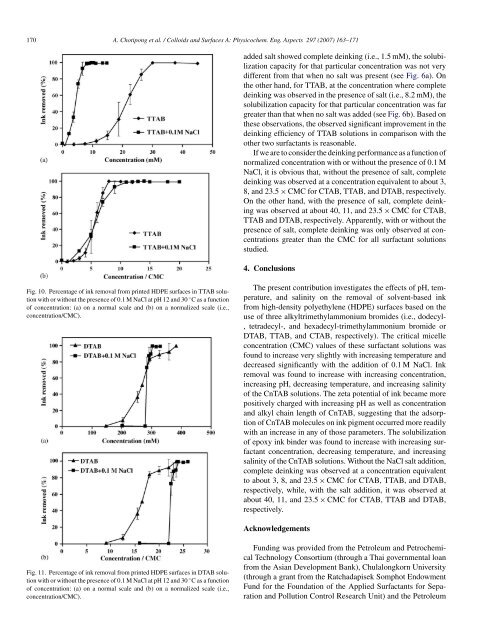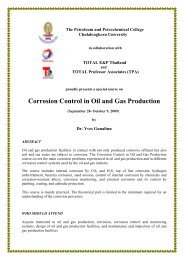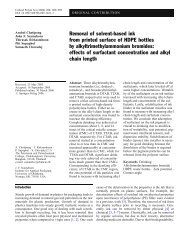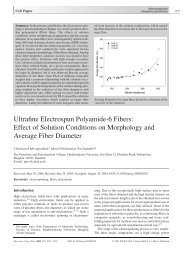Removal of solvent-based ink from printed surface - The Petroleum ...
Removal of solvent-based ink from printed surface - The Petroleum ...
Removal of solvent-based ink from printed surface - The Petroleum ...
You also want an ePaper? Increase the reach of your titles
YUMPU automatically turns print PDFs into web optimized ePapers that Google loves.
170 A. Chotipong et al. / Colloids and Surfaces A: Physicochem. Eng. Aspects 297 (2007) 163–171<br />
Fig. 10. Percentage <strong>of</strong> <strong>ink</strong> removal <strong>from</strong> <strong>printed</strong> HDPE <strong>surface</strong>s in TTAB solution<br />
with or without the presence <strong>of</strong> 0.1 M NaCl at pH 12 and 30 ◦ C as a function<br />
<strong>of</strong> concentration: (a) on a normal scale and (b) on a normalized scale (i.e.,<br />
concentration/CMC).<br />
Fig. 11. Percentage <strong>of</strong> <strong>ink</strong> removal <strong>from</strong> <strong>printed</strong> HDPE <strong>surface</strong>s in DTAB solution<br />
with or without the presence <strong>of</strong> 0.1 M NaCl at pH 12 and 30 ◦ C as a function<br />
<strong>of</strong> concentration: (a) on a normal scale and (b) on a normalized scale (i.e.,<br />
concentration/CMC).<br />
added salt showed complete de<strong>ink</strong>ing (i.e., 1.5 mM), the solubilization<br />
capacity for that particular concentration was not very<br />
different <strong>from</strong> that when no salt was present (see Fig. 6a). On<br />
the other hand, for TTAB, at the concentration where complete<br />
de<strong>ink</strong>ing was observed in the presence <strong>of</strong> salt (i.e., 8.2 mM), the<br />
solubilization capacity for that particular concentration was far<br />
greater than that when no salt was added (see Fig. 6b). Based on<br />
these observations, the observed significant improvement in the<br />
de<strong>ink</strong>ing efficiency <strong>of</strong> TTAB solutions in comparison with the<br />
other two surfactants is reasonable.<br />
If we are to consider the de<strong>ink</strong>ing performance as a function <strong>of</strong><br />
normalized concentration with or without the presence <strong>of</strong> 0.1 M<br />
NaCl, it is obvious that, without the presence <strong>of</strong> salt, complete<br />
de<strong>ink</strong>ing was observed at a concentration equivalent to about 3,<br />
8, and 23.5 × CMC for CTAB, TTAB, and DTAB, respectively.<br />
On the other hand, with the presence <strong>of</strong> salt, complete de<strong>ink</strong>ing<br />
was observed at about 40, 11, and 23.5 × CMC for CTAB,<br />
TTAB and DTAB, respectively. Apparently, with or without the<br />
presence <strong>of</strong> salt, complete de<strong>ink</strong>ing was only observed at concentrations<br />
greater than the CMC for all surfactant solutions<br />
studied.<br />
4. Conclusions<br />
<strong>The</strong> present contribution investigates the effects <strong>of</strong> pH, temperature,<br />
and salinity on the removal <strong>of</strong> <strong>solvent</strong>-<strong>based</strong> <strong>ink</strong><br />
<strong>from</strong> high-density polyethylene (HDPE) <strong>surface</strong>s <strong>based</strong> on the<br />
use <strong>of</strong> three alkyltrimethylammonium bromides (i.e., dodecyl-<br />
, tetradecyl-, and hexadecyl-trimethylammonium bromide or<br />
DTAB, TTAB, and CTAB, respectively). <strong>The</strong> critical micelle<br />
concentration (CMC) values <strong>of</strong> these surfactant solutions was<br />
found to increase very slightly with increasing temperature and<br />
decreased significantly with the addition <strong>of</strong> 0.1 M NaCl. Ink<br />
removal was found to increase with increasing concentration,<br />
increasing pH, decreasing temperature, and increasing salinity<br />
<strong>of</strong> the CnTAB solutions. <strong>The</strong> zeta potential <strong>of</strong> <strong>ink</strong> became more<br />
positively charged with increasing pH as well as concentration<br />
and alkyl chain length <strong>of</strong> CnTAB, suggesting that the adsorption<br />
<strong>of</strong> CnTAB molecules on <strong>ink</strong> pigment occurred more readily<br />
with an increase in any <strong>of</strong> those parameters. <strong>The</strong> solubilization<br />
<strong>of</strong> epoxy <strong>ink</strong> binder was found to increase with increasing surfactant<br />
concentration, decreasing temperature, and increasing<br />
salinity <strong>of</strong> the CnTAB solutions. Without the NaCl salt addition,<br />
complete de<strong>ink</strong>ing was observed at a concentration equivalent<br />
to about 3, 8, and 23.5 × CMC for CTAB, TTAB, and DTAB,<br />
respectively, while, with the salt addition, it was observed at<br />
about 40, 11, and 23.5 × CMC for CTAB, TTAB and DTAB,<br />
respectively.<br />
Acknowledgements<br />
Funding was provided <strong>from</strong> the <strong>Petroleum</strong> and Petrochemical<br />
Technology Consortium (through a Thai governmental loan<br />
<strong>from</strong> the Asian Development Bank), Chulalongkorn University<br />
(through a grant <strong>from</strong> the Ratchadapisek Somphot Endowment<br />
Fund for the Foundation <strong>of</strong> the Applied Surfactants for Separation<br />
and Pollution Control Research Unit) and the <strong>Petroleum</strong>





